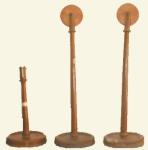Description
The painted zinc pulleys are held by brass flasks with steel axes. They move with
negligible friction.
We can verify that the power equals the strength in the fixed pulley; in the mobile
pulley the power is half the strength, and in the other compound types, the power is a sixth
of the strength.
By hanging a scale to the horizontal bar of the support, and reading the vertical shifts
of the application point of the power and of the strength, we can verify that in every case the
work executed by the power is equal to that required by the strength, and that the engines
create or multiply do not the work, but only modify the two factors that determine it.
A set of twelve equal weights to be applied to the support is given along with the apparatus.
|


 Menu
Menu














